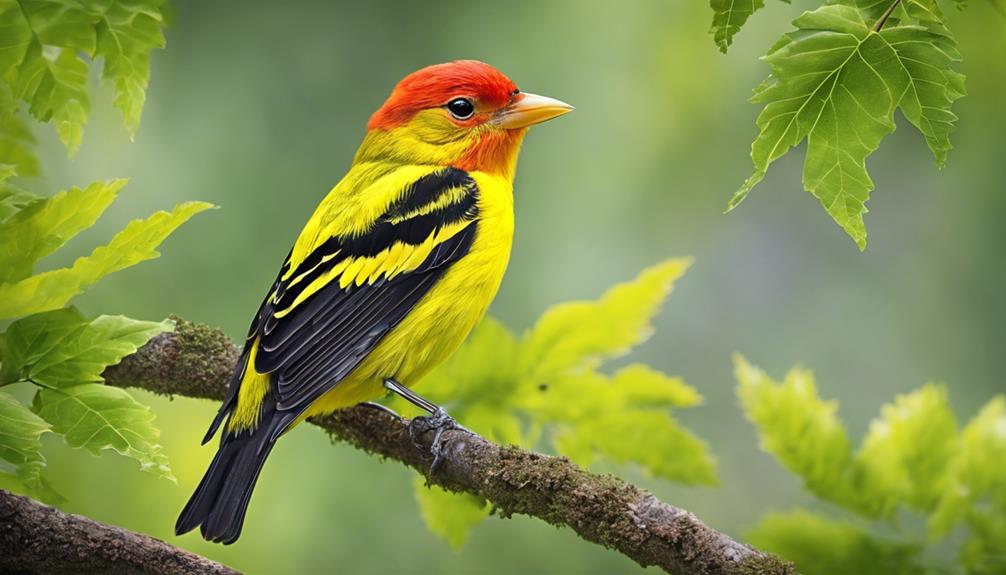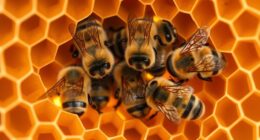Squirrel-proof bird feeders really do work! They use clever mechanisms, like weight-activated closures and spring-loaded perches, to keep squirrels out while allowing smaller birds to feast. With durable materials like polycarbonate and metal, these feeders stand up to weather and squirrel attacks. Models like the Brome Squirrel Buster Plus and Perky-Pet Squirrel-Be-Gone are popular choices among bird enthusiasts. To maximize effectiveness, make sure to position your feeder away from trees and structures. You'll find that a little knowledge about the right feeder can go a long way in enhancing your birdwatching experience.
Key Takeaways
- Squirrel-proof feeders utilize weight-activated mechanisms and physical barriers to effectively deter squirrels from accessing birdseed.
- Durable materials like polycarbonate and metal enhance the longevity of squirrel-proof feeders against chewing and weather.
- Popular models, such as the Brome Squirrel Buster Plus, are highly rated for effectively keeping squirrels away while attracting smaller birds.
- Regular maintenance, including cleaning and monitoring seed levels, is essential to ensure the effectiveness of these feeders.
- Strategic placement, such as positioning feeders away from trees and removing nearby launch points, further enhances their deterrent capabilities.
Understanding Squirrel-Proof Feeders
When it comes to bird feeding, understanding squirrel-proof feeders is vital for protecting your seed supply. These feeders use weight-activated mechanisms that close seed ports when heavier animals, like squirrels, try to access the food. This design allows only smaller birds to enjoy the seeds, keeping your feeding environment healthy and thriving.
Additionally, incorporating features such as durable materials can enhance the longevity of your feeder while deterring persistent squirrels. Many squirrel-proof feeders incorporate additional features, such as metal shrouds and sloped tops, which further deter squirrel access. To enhance their effectiveness, you'll need to guarantee at least 18 inches of clearance around the feeder, minimizing the chance of squirrels jumping from nearby branches or structures.
Durability plays a significant role in choosing the right feeder. High-quality squirrel-proof designs are often made from robust materials like polycarbonate and metal, guaranteeing they withstand various outdoor elements and persistent squirrel attempts.
Regular maintenance is equally important; cleaning the feeder and monitoring seed levels helps maintain its functionality while creating a welcoming atmosphere for birds. By understanding these key aspects of squirrel-proof feeders, you can enjoy watching your feathered friends without the constant worry of squirrel interference.
How They Function

Squirrel-proof bird feeders use clever mechanisms to keep unwanted visitors at bay.
These feeders often feature well-designed components that are built to withstand various weather conditions, ensuring durability and longevity in your backyard.
When a heavier animal lands on them, weight-activated systems close off access to the food, while various design features like metal shrouds and sloped tops add extra protection.
Understanding these functions will help you choose the right feeder for your backyard, especially if you're also considering energy-efficient models that reduce power consumption.
Mechanisms of Deterrence
Bird enthusiasts often find that squirrel-proof bird feeders employ clever mechanisms to keep those pesky critters at bay while allowing smaller birds to feast. Many of these feeders use weight-activated mechanisms that shut the seed ports when a heavier animal, like a squirrel, tries to access the food. This allows lighter birds to feed without interruption.
Additionally, these feeders can be quite affordable, similar to budget-friendly vacuum cleaners, providing effective solutions for both birdwatchers and homeowners.
To enhance deterrent effectiveness, some designs feature metal shrouds or sloped tops that physically block squirrels from reaching the seed openings. Additionally, feeders with spring-loaded perches automatically close off access to seeds when larger birds attempt to land, guaranteeing that only the intended visitors enjoy the meal.
The use of durable materials, such as polycarbonate and metal, means your feeder can withstand outdoor conditions while maintaining its deterrent functions over time.
However, regular maintenance is essential. Cleaning the feeder and checking weight adjustments guarantee that these innovative mechanisms continue to function effectively and prevent squirrel access.
With the right bird feeder design, you can enjoy peaceful birdwatching without the nuisance of squirrels raiding your bird feeder.
Design Variations Explained
To keep squirrels at bay, various design variations of bird feeders incorporate innovative functions that enhance their effectiveness. Squirrel-proof feeders typically utilize weight-sensitive mechanisms that close access ports when a heavier animal lands, ensuring only smaller birds can feed.
| Design Feature | Functionality | Benefits |
|---|---|---|
| Weight-Sensitive | Closes access ports under excess weight | Limits squirrel access |
| Durable Materials | Constructed from polycarbonate and metal | Resists chewing and weather |
| Baffles | Curved surfaces prevent climbing | Discourages squirrel approach |
| Tube Feeders | Sloped tops and protected seed ports | Accommodates various bird species |
Additionally, many models come with adjustable perch lengths and weight settings, allowing you to customize access for different bird sizes. This feature considerably enhances feeding efficiency by attracting a wider variety of bird species. With these design variations, you can enjoy watching birds without the constant worry of squirrels raiding the feeder.
Popular Squirrel-Proof Models

When it comes to feeding birds without the hassle of squirrels raiding your feeder, several popular models stand out for their effective designs. The Brome Squirrel Buster Plus features a weight-activated mechanism that closes access to seed ports when squirrels attempt to feed, ensuring only smaller birds can enjoy the seeds.
Additionally, if you have pets at home, consider how having a self-cleaning mechanism in your vacuum can simplify your cleaning routine, especially when dealing with pet hair.
If you're looking for something with added security, the Perky-Pet Squirrel-Be-Gone offers shake-resistant ports and a locking top to prevent spillage and keep squirrels at bay.
For a budget-friendly option, consider the Brome Squirrel Buster Mini. This model has a mesh grid that allows smaller birds to perch while deterring pesky squirrels effectively.
Another unique choice is the Droll Yankees Yankee Flipper, which utilizes a motorized spinning mechanism that ejects squirrels, providing a fun and non-lethal deterrent.
Finally, the Woodlink Absolute II features spring-activated perches that adjust according to weight, making it ideal for accommodating smaller birds while excluding larger animals like squirrels and grackles.
With these models, you can create a squirrel-proof feeding station that attracts your favorite birds without the interruptions!
Effective Squirrel Deterrent Strategies

To keep squirrels away from your bird feeders, you can implement several effective strategies.
Installing features like squirrel baffles and using weight-activated feeders can create barriers that thwart their attempts to snack on birdseed.
Additionally, placing your feeders strategically with enough clearance can greatly reduce the chances of squirrels making a successful leap.
Design Mechanisms and Features
Squirrel-proof bird feeders incorporate innovative design mechanisms that effectively deter these pesky critters while ensuring smaller birds can access food.
The key features that make these feeders successful include:
- Weight-Activated Mechanisms: These close the seed ports when heavier animals, like squirrels, try to feed, allowing only lighter birds to enjoy the seeds. Additionally, these mechanisms can enhance your overall outdoor experience, similar to how sound system configuration improves audio immersion in home theaters.
- Barriers: Metal shrouds or cages physically block squirrels, while still permitting smaller birds to reach the food.
- Baffles: Installed above or below feeders, baffles prevent squirrels from climbing down from trees or up from the ground.
The materials used in these feeders, such as polycarbonate and metal, enhance their durability and resistance to chewing, a common problem with squirrels.
Many models also feature adjustable settings, allowing you to modify the weight threshold for seed access. This customization helps you deter unwanted bird species as well as squirrels.
Strategic Placement Techniques
How can you effectively keep squirrels away from your bird feeders? One key strategy is strategic placement. Start by positioning feeders at least 18 inches away from tree trunks and structures. Since squirrels can leap up to ten times their body length, keeping feeders this distance minimizes access.
Installing squirrel baffles on poles or hanging feeders from wires at least five feet off the ground further prevents squirrels from reaching your bird food. Additionally, consider using safety features similar to those found in modern garage door openers, which can enhance your overall bird feeding setup.
Make sure the area surrounding the feeder is clear of any objects, like branches or fences, that could serve as launching pads for these agile critters. Regularly monitor your feeders and adjust their height and location based on squirrel activity and seasonal changes; this proactive approach can enhance your deterrence efforts.
Incorporating weight-activated mechanisms into your feeder designs can also be highly effective. These mechanisms close off seed access when a heavier animal, such as a squirrel, attempts to feed.
Customer Experiences and Feedback

As customers share their experiences with squirrel-proof bird feeders, many express high satisfaction due to the feeders' effectiveness in keeping squirrels at bay while attracting a variety of birds, like American Goldfinches and House Finches.
Remarkably, similar to how Gold IRAs provide a hedge against inflation, these feeders help maintain a thriving bird population by preventing seed loss to pesky squirrels. You'll find that these feeders not only enhance your backyard birding but also save you money in the long run.
Here are some common themes from customer feedback:
- Ease of Maintenance: Users appreciate how easy it's to fill and clean their squirrel-proof feeders. Models like the Squirrel Buster Plus allow for quick disassembly, making maintenance a breeze.
- Weight Mechanisms: Many highlight the adjustable weight mechanisms, which let you customize the feeder to block larger birds while welcoming smaller species. This feature considerably increases your bird activity.
- Long-Term Investment: Customers often mention that while the initial cost of quality feeders is higher, the reduction in wasted birdseed from squirrel interference makes it a smart investment.
Choosing the Right Feeder

Choosing the right feeder can greatly impact your backyard birding experience. When you're in the market for a squirrel-proof feeder, look for models with weight-activated mechanisms, like the Brome Squirrel Buster Plus. These effectively close access to seed ports when heavier animals, such as squirrels, try to feed.
To enhance your birding experience, consider the diverse landscapes and seasonal changes that might attract different bird species to your feeder—especially during summer and fall when they're most active unique experiences such as stargazing. Opt for feeders made from durable materials like polycarbonate and metal; these can withstand various weather conditions and resist squirrel damage.
Consider the feeder's capacity and design too. A feeder that holds between 1.4 and 3 quarts of seed is often ideal, attracting a variety of bird species while minimizing the need for frequent refills.
Placement is essential; hang your feeder at least 18 inches away from tree trunks and branches to prevent squirrels from jumping onto them.
Additionally, selecting feeders with adjustable perches or built-in squirrel baffles can enhance effectiveness in deterring squirrels while accommodating different bird sizes. By choosing wisely, you can create an inviting space for birds, ensuring your backyard remains a lively and enjoyable environment.
Frequently Asked Questions
Do Squirrel-Proof Bird Feeders Really Work?
You'll find that squirrel-proof bird feeders can be quite effective when placed correctly and maintained well. Many users report less seed waste and greater bird activity, proving their design can deter those pesky squirrels successfully.
Where to Put Bird Feeder so Squirrels Don't Get It?
Imagine a fortress for your feathered friends. Position your bird feeder at least 10-12 feet away from trees and fences, ensuring 18 inches of clearance, and elevate it at least 5 feet off the ground.
Does Feeding Squirrels Keep Them Away From Bird Feeders?
Feeding squirrels can help divert them from bird feeders, but it might not be a foolproof solution. If they find your offerings appealing, they could still be drawn to the bird food nearby.
What Do Squirrels Hate That Birds Don T?
Squirrels hate spicy foods like chili peppers, which birds don't mind at all. You can use chili-infused birdseed or safflower seeds to attract birds while keeping those pesky squirrels away from your feeders.
Conclusion
So, you've invested in a squirrel-proof bird feeder, thinking you've outsmarted those furry little bandits. Ironically, they might just be plotting their next acrobatic heist while you enjoy your feathered friends. But don't worry—these feeders do have their merits! With the right model and some clever deterrent strategies, you can create a peaceful haven for birds. Just remember, in the battle of wits, the squirrels are always one leap ahead!










